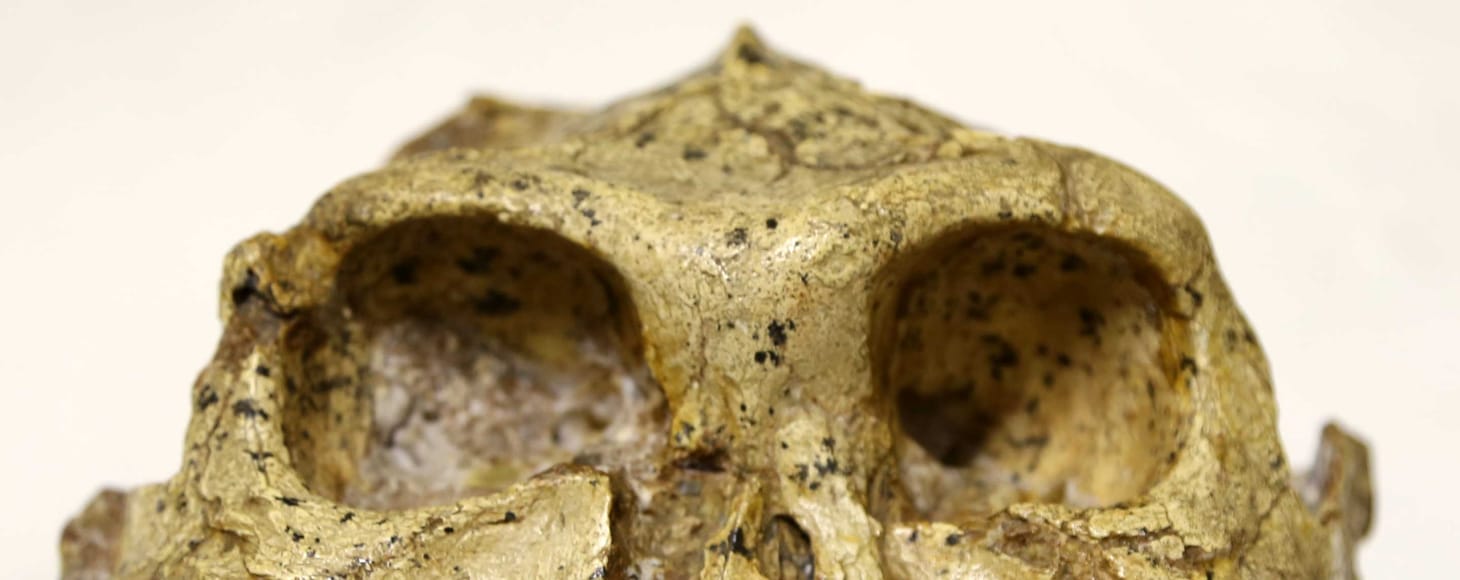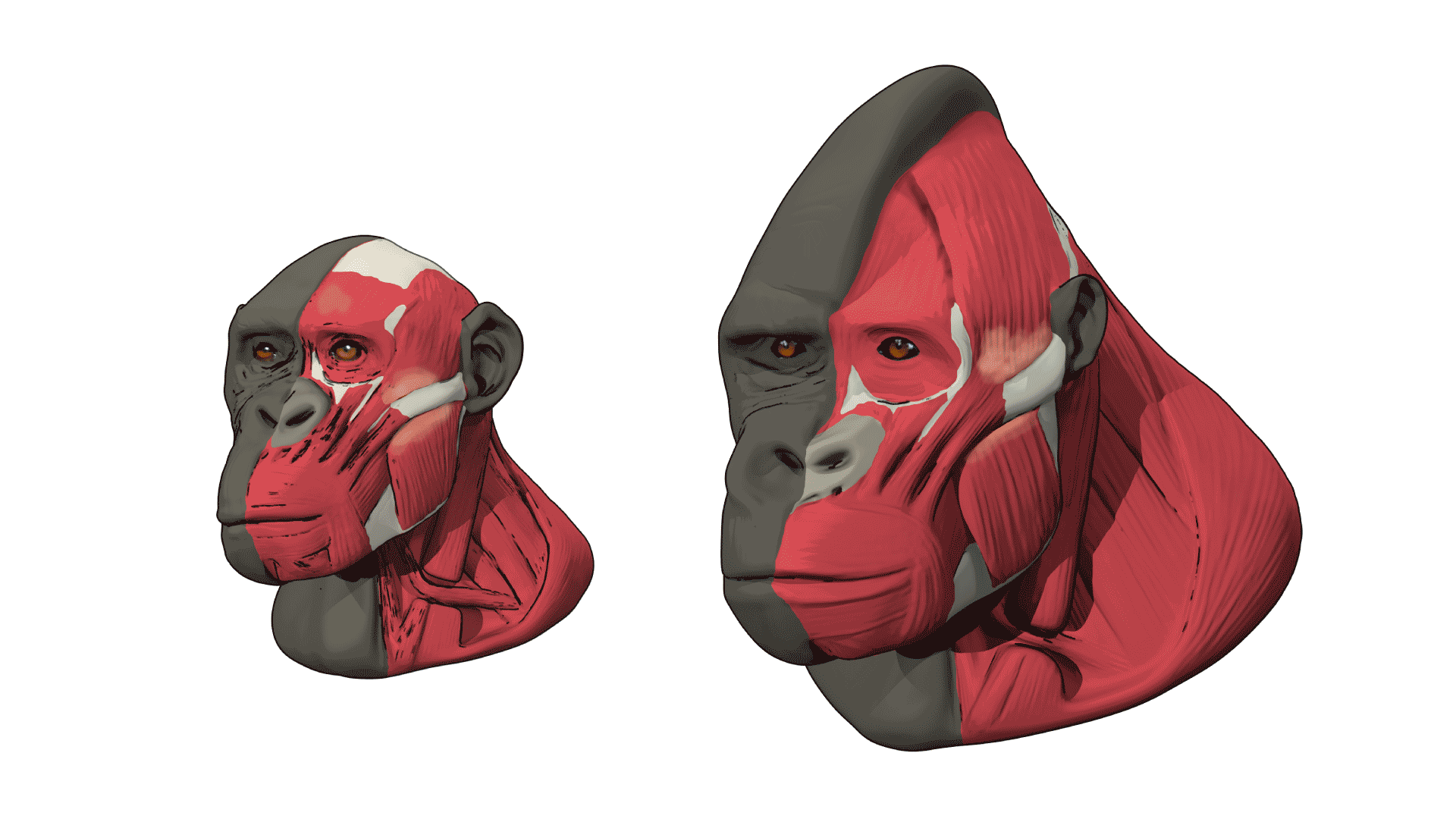Guide to Sahelanthropus, Orrorin and Ardipithecus
These fossil species between 8 million and 4.4 million years old include some of the earliest members of the hominin lineage.
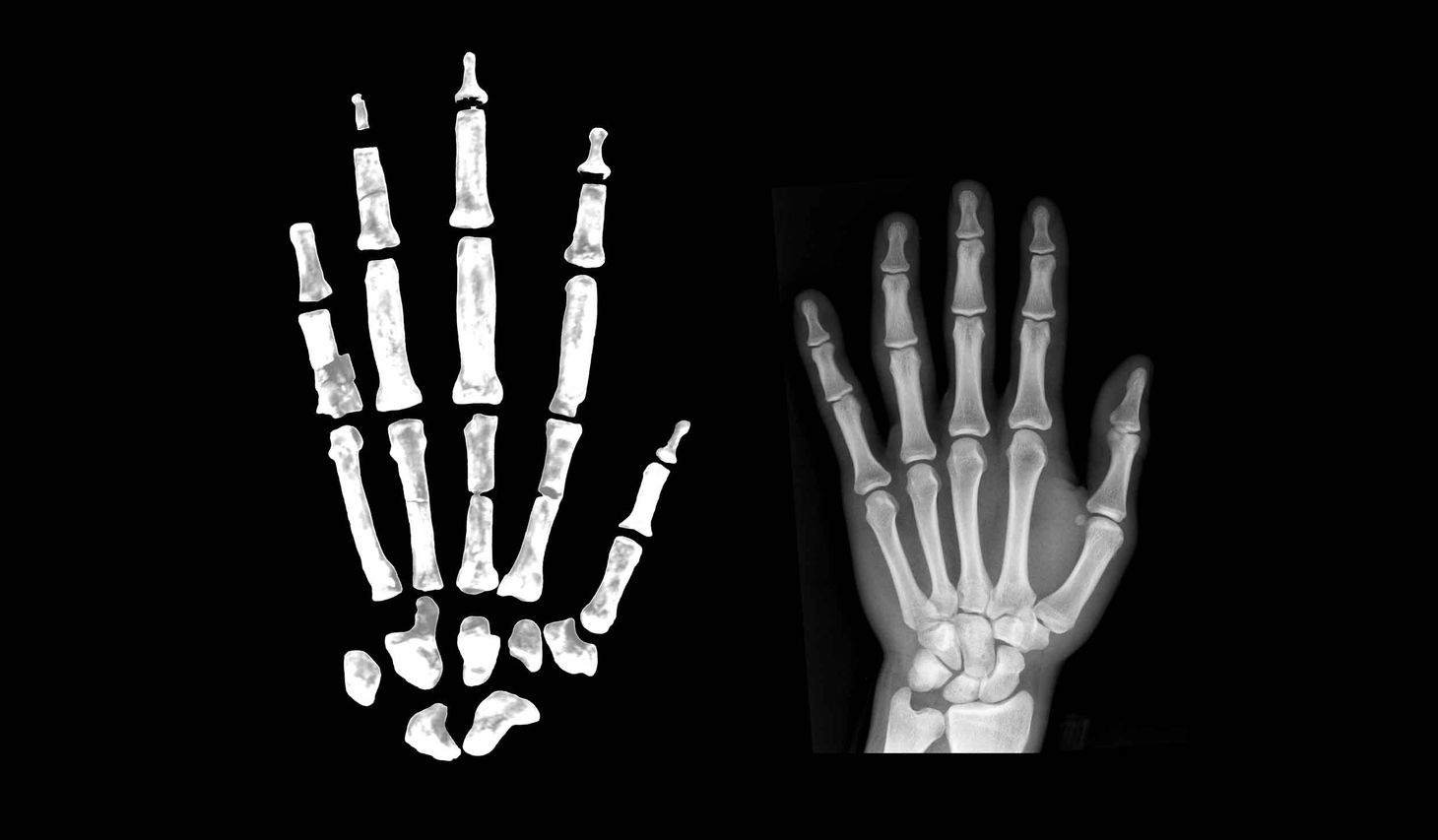
The line to hominins began between 6 million and 8 million years ago when we last shared common ancestors with living bonobos and chimpanzees. Paleontologists have not yet identified fossils of the last common ancestor that we share with these closest living relatives. What scientists know about its geological age comes from comparing the genomes of its living descendants. This calculation has a wide range of uncertainty, in part because the ancestral species had high genetic diversity, much of it retained across the million years or more following the split from our next closest living relatives, the gorillas. That high diversity suggests that the human-chimpanzee-bonobo ancestors had large population sizes, possibly arrayed across partially-isolated regional groupings.
Scientists' knowledge of the paleontology of Africa from 8 million to 4.4 million years ago comes mostly from three small regions in Chad, Kenya, and Ethiopia. Geological layers in each of these areas preserve evidence of large apes. Scientists have attributed them to five species in three genera: Sahelanthropus, Orrorin, and Ardipithecus. Each of these fossil species shares some traits with better-known human relatives from later in time, like Australopithecus. Skeletal adaptations to upright bipedal locomotion are hallmarks of all later hominins, and such adaptations can be found in a limited way in some of these species. This suggests that these species are more closely related to hominins than the gorilla or chimpanzee lineages.
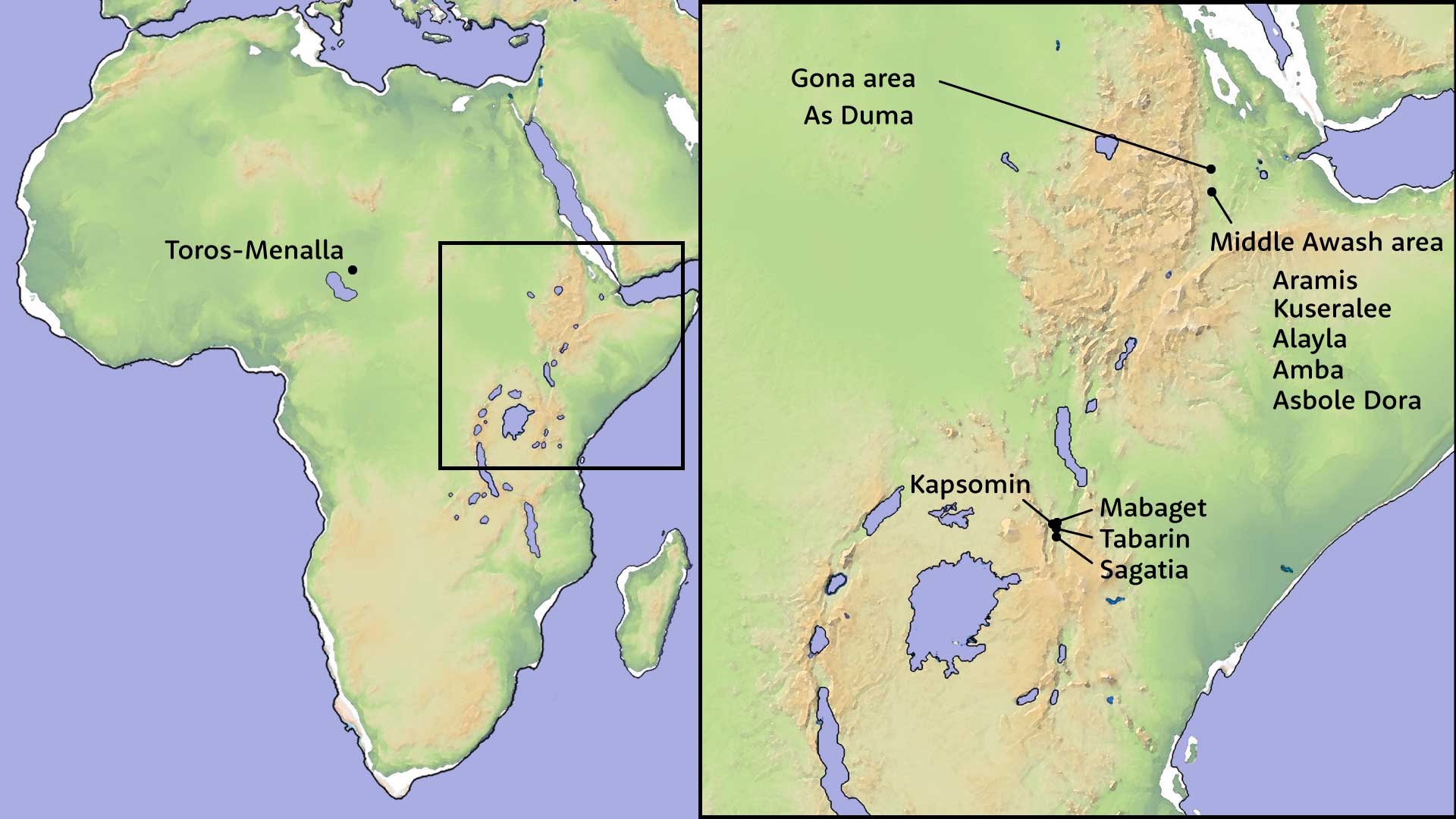
But each differs strikingly with hominins like Australopithecus or Homo in other ways. Many dental, mandibular, and cranial features shared by Australopithecus and some species of Homo but are not found in Sahelanthropus, Orrorin, or Ardipithecus. The early species with the highest representation of postcranial anatomy, Ardipithecus ramidus, had apelike grasping feet, elongated fingers, and pelvic anatomy that was different from any later hominin. The evidence does not make it easy to work out how these species are related to later hominins or to each other.
Information about these early hominins has been increasing. Sahelanthropus, Orrorin, and Ardipithecus were all first named within the last 30 years, with key fossil discoveries from the mid-1990s into the 2010s. It took many years for researchers to interpret and make public some of these fossils. Postcranial fossils of Sahelanthropus tchadensis, for example, were first described in 2022, twenty years after the first cranial and dental fossils. Today scientists are also benefiting from new research with a greater depth of analysis of many fossils of Ar. ramidus and O. tugenensis. These kinds of studies are leading to a greater understanding of what the human-chimpanzee-bonobo common ancestor may have been like.

Sahelanthropus tchadensis
- Only appearance: 7.2–6.8 million years, Toros-Menalla, Chad
- Holotype: TM 266-01-060-1 fossil cranium, Toros-Menalla, Chad
- Named by: Michel Brunet and coworkers in 2002.
- Etymology: Sahel refers to the region of north-central Africa, and anthropos is the Greek word for “human”. The species name tchadensis refers to the nation of Chad (Tchad in French).
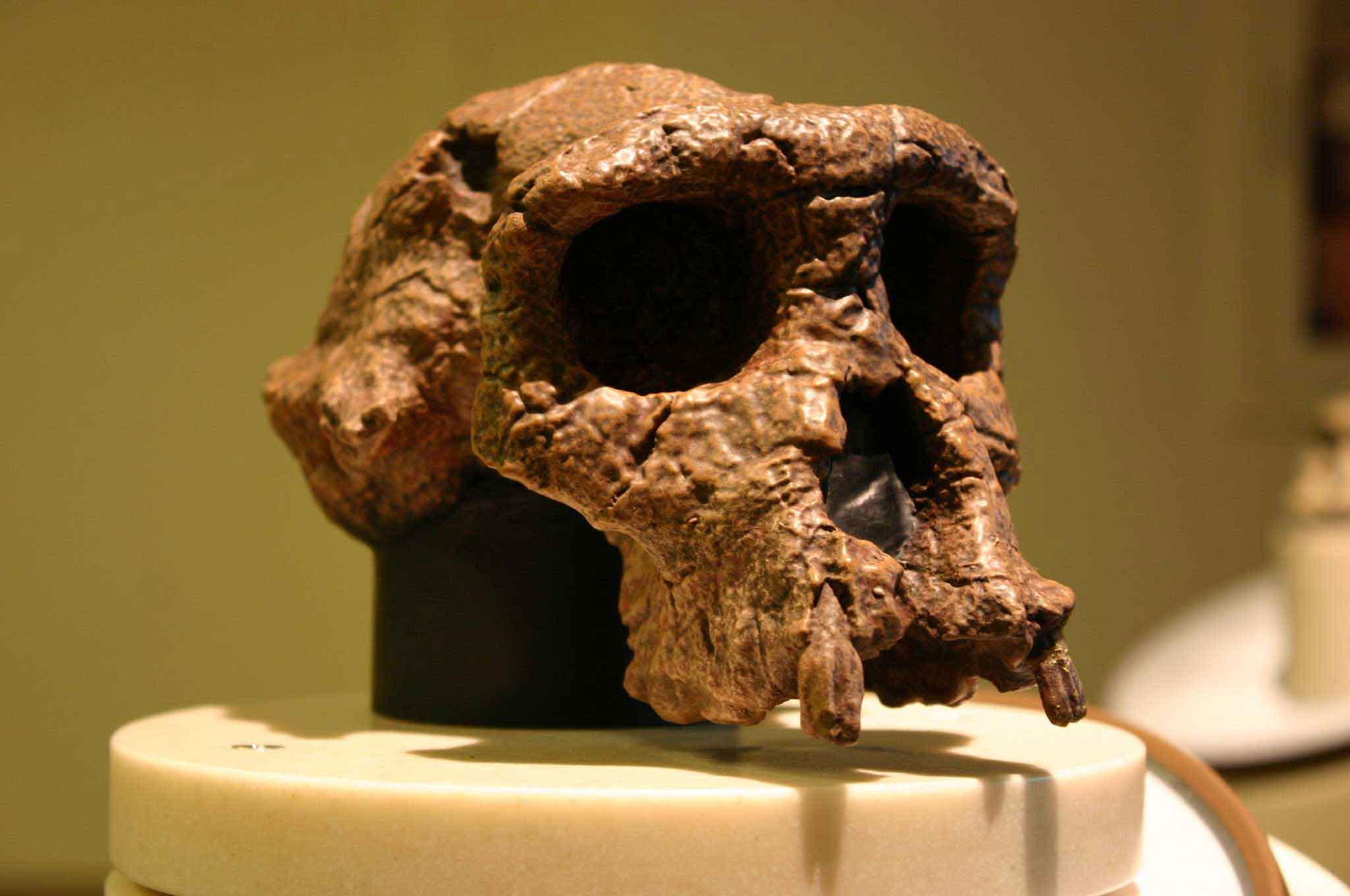
Around seven million years ago, this species of apelike primates was living near the edge of a lake in north-central Africa. A combined French and Chadian research team in 2001 and 2002 found ancient primate fossils at three localities, all within a kilometer of each other in the Toros-Menalla area, in the Djurab Desert of northern Chad. Most of the fossils came from one locality, designated TM 266, including a skull, mandible, femur, and two ulnae. Michel Brunet and collaborators designated the skull and mandible as S. tchadensis.
The Toros-Menalla fossils share some features that can also be seen in hominins that lived much later, such as Australopithecus. For example, the upper canine tooth of the S. tchadensis skull has wear on its tip, similar to Australopithecus canine wear. This is different from chimpanzees, bonobos, or other living great apes. Those apes have upper canine teeth that slice against the lower third premolar, which has a pointed cusp and crest extending along its front. That kind of slicing action between the canine and premolar is called C/P3 honing.
Another similarity with hominins is on the base of the S. tchadensis skull, where its foramen magnum is further forward than in living great apes. This suggests that this species held its torso and head upright more often than these primates. The skull overall is smaller than most known hominins, with a large and projecting browridge that does not resemble any known Australopithecus.
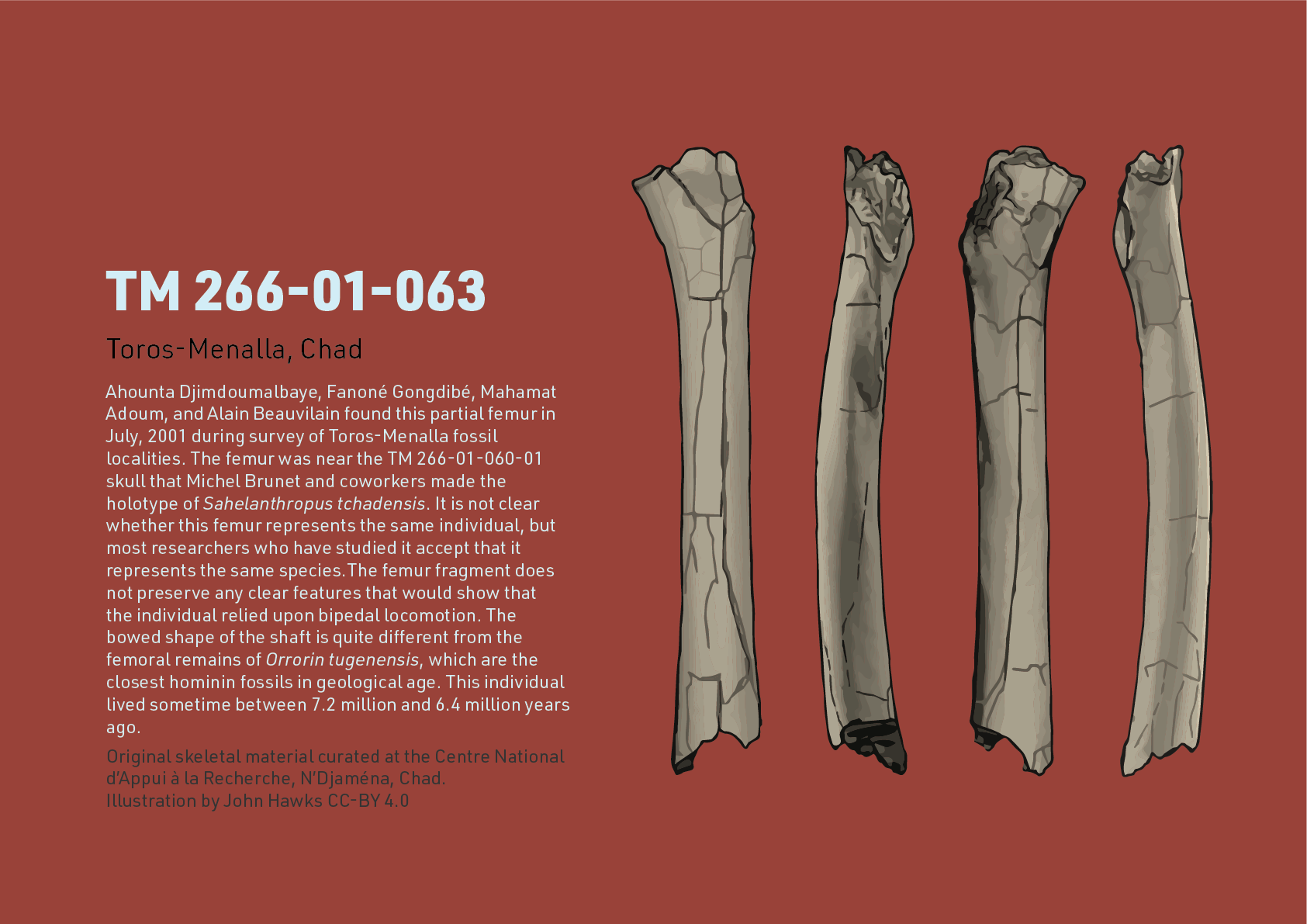
Only recently has the postcranial skeleton of S. tchadensis been studied, showing that this species had a different pattern of movement than humans or Australopithecus. The ulnae have curved shafts and cross-sections that are thickened in the front-to-back dimension, suggesting a larger role for climbing than in most Australopithecus species. The fossil femur TM 266-01-050 does not preserve the parts most informative about locomotion, particularly the head, neck, and distal end, and two analyses of its morphology came to different conclusions about how much S. tchadensis may have relied on bipedal weight support. In combination with the evidence from the base of the skull, the femur may suggest that S. tchadensis used upright postures while climbing and did not share the knuckle-walking pattern of movement used by living chimpanzees, bonobos, or gorillas. The femur and ulna size both suggest a body mass around 40–50 kg, comparable to large male chimpanzees.
Orrorin tugenensis
- First appearance: 6.05–5.89 million years, Aragai, Kenya
- Last appearance: 5.72–5.66 million years, Kapcheberek, Kenya
- Holotype: BAR 1000’00 fossil mandible, Kapsomin, Kenya
- Named by: Brigitte Senut and coworkers in 2001.
- Etymology: Orrorin is a word from the Tugen language that means “original man”. The species name tugenensis refers to the Tugen Hills where fossils of this species were first found.
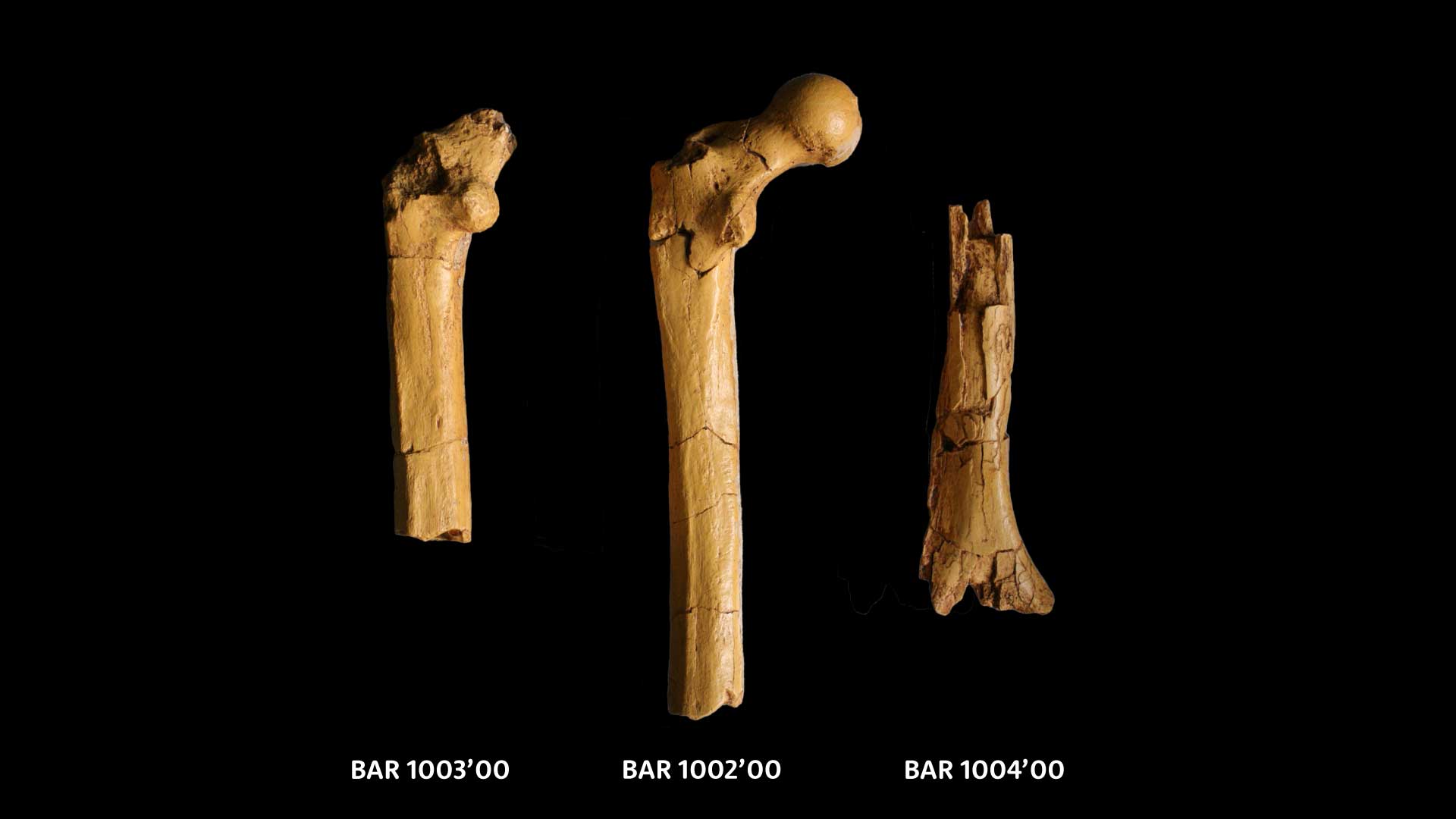
Martin Pickford found a single isolated molar from the Lukeino Formation west of Lake Baringo in 1975. Later survey of this area recovered around a dozen fossil specimens from the locality known as Kapsomin, where a gully eroded through sediments of around 5.9 million years ago. These fossils included a fragmented mandible and several additional teeth, as well as parts of three femora and a partial humerus. With a description led by Brigitte Senut in 2001, the team identified these as the oldest hominin known at that time, naming it Orrorin tugenensis.
The fossil femora are similar to later hominins like Australopithecus in their preserved parts. The cross-section of the shaft, the length and angulation of the femoral neck, and the distribution of cortical bone around it are all similar to bipedal hominins. While none of the femur fossils include the knee joint, the overall pattern shows that the lower limb of O. tugenensis supported weight in upright postures and the species moved bipedally. The distal portion of the humerus is similar to both chimpanzees and Australopithecus fossils in its size and morphology, which likely indicates that O. tugenensis relied a lot on climbing. The three femora and fossil humerus all are consistent with a body mass around 30–40 kg, similar to Australopithecus.
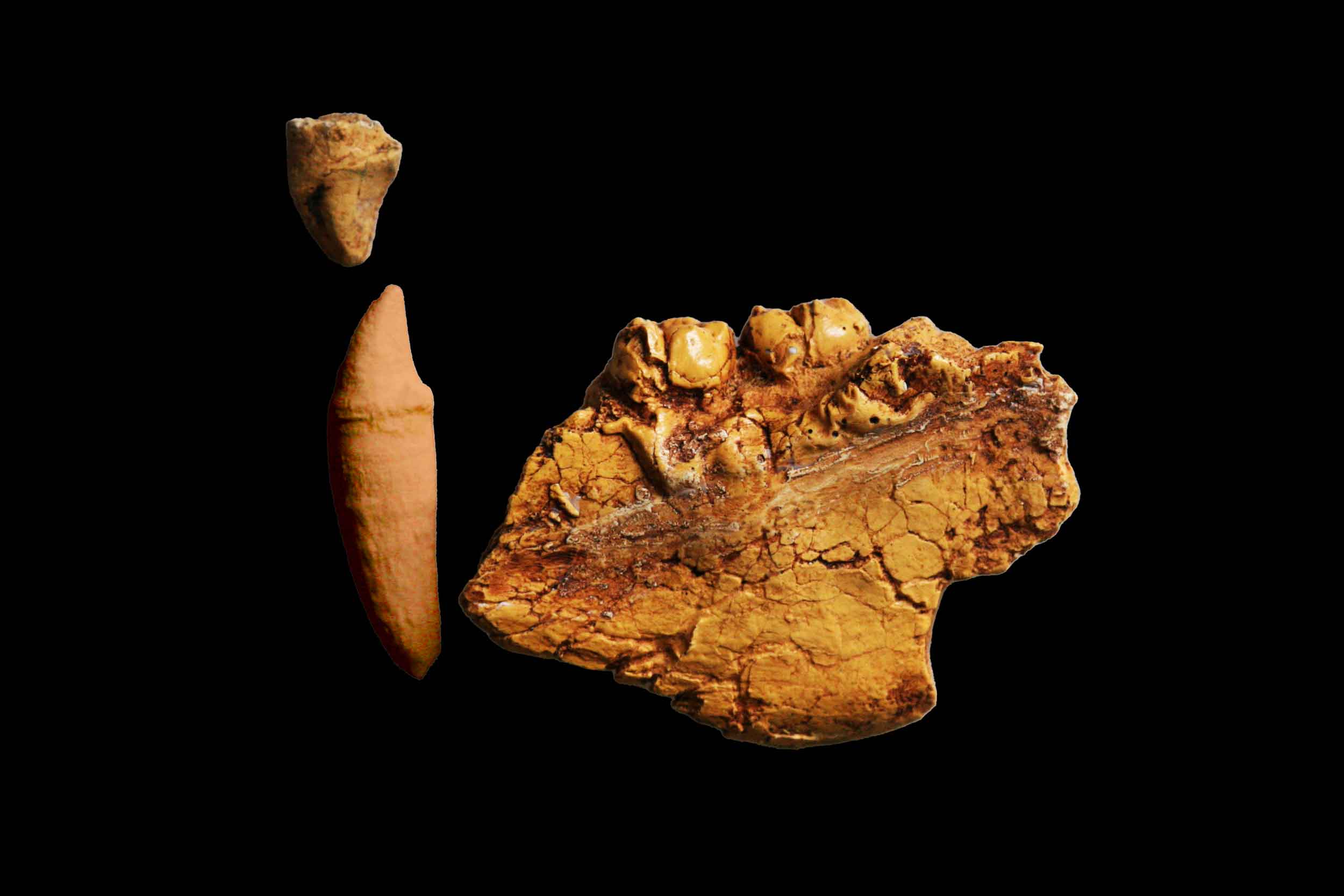
The molar and premolar teeth of O. tugenensis are similar in size to those of S. tchadensis, smaller than later hominins like Australopithecus afarensis. The upper and lower canine teeth are approximately the same size as those of female bonobos, with smaller roots, and with slight wear on the tip of the upper canine as in S. tchadensis. As in that species, this evidence suggests a lack of C/P3 honing in Orrorin.
Orrorin praegens
- First appearance: 5.0–4.4 million years, Magabet, Kenya
- Last appearance: 5.0–4.4 million years, Sagatia, Kenya
- Holotype: KNM-TH 13150 fossil mandible fragment, Tabarin, Kenya
- Named by: Walter Ferguson in 1989. Ferguson argued that the KNM-TH 13150 mandible, which had been described by Steven Ward and Andrew Hill in 1987, was actually a form of Homo that he named Homo antiquus praegens. The KNM-TH 13150 specimen was referred to Orrorin by Martin Pickford and coworkers in 2022.
- Etymology: The Latin term praegens means roughly “group of people who came before.”
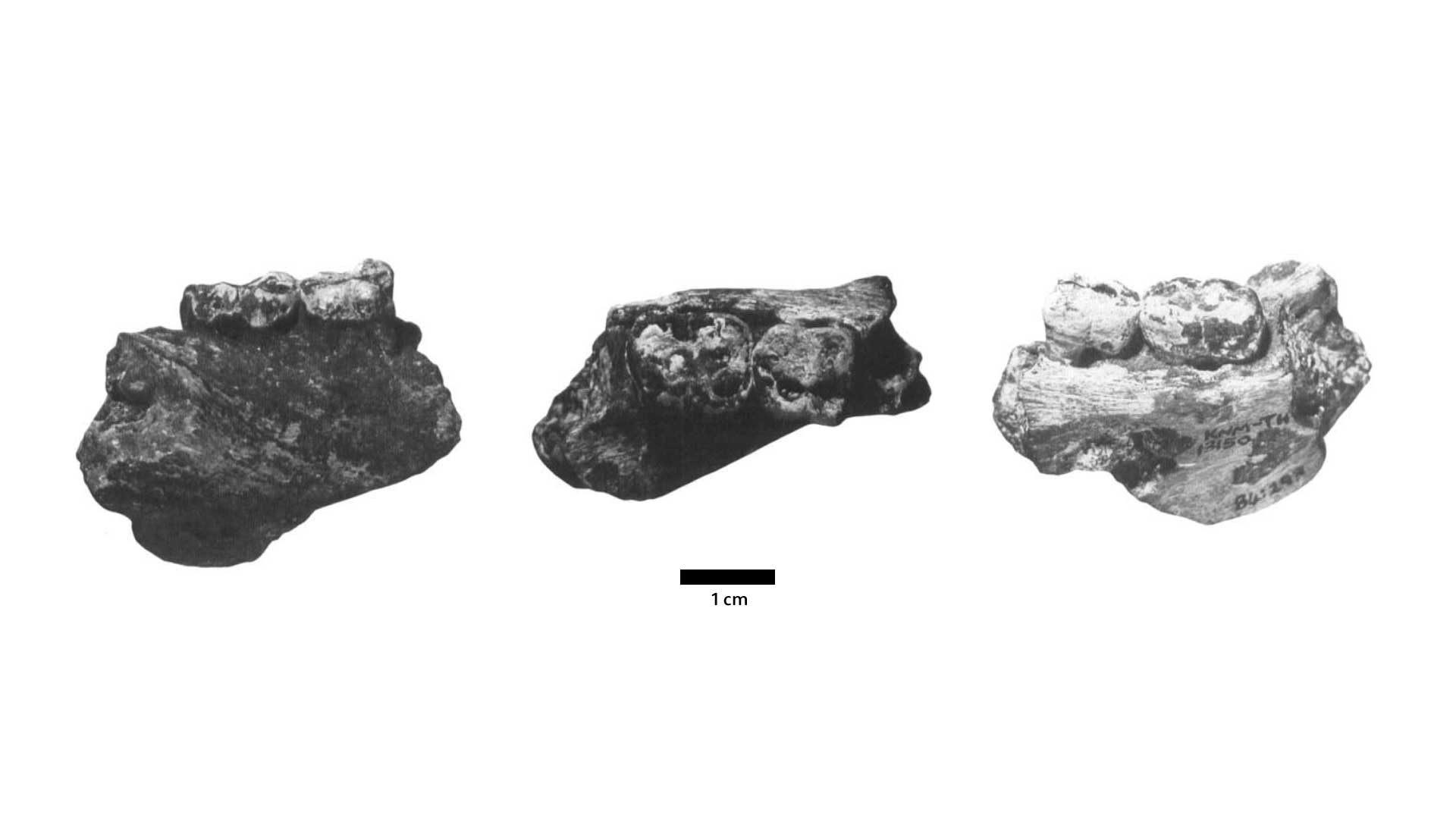
Paleontological survey of the area west of Lake Baringo during the early 1980s led to the discovery of a fragment of hominin mandible by Kiptalam Cheboi at a site called Tabarin. This fossil came from sediments now identified as the Mabaget Formation, which dates to between 5.0 and 4.4 million years ago and overlies the Lukeino Formation that contains fossils of O. tugenensis. With smaller molars than known samples of Australopithecus, the anthropologist Walter Ferguson judged that the jaw might belong to an early form of Homo and named it Homo antiquus praegens in a 1989 article. In a 2015 paper, Marc Kissel and I analyzed this mandibular fragment in comparison with the larger record of hominins discovered since 1990. We could confirm that the fossil differs from all known Australopithecus in its molar sizes and some other details, but we thought it might fit within Ardipithecus.
Further work by Martin Pickford and collaborators brought to light additional teeth and a mandibular fragment from Mabaget, all from around the same time as the mandible from Tabarin. The combined sample shows a few differences from Ardipithecus, including thicker tooth enamel. Pickford and coworkers attributed these fossils to Orrorin, recognizing them as a later sample from O. tugenensis and reviving the species name praegens for them.
These fossils are suggestive but so far provide little evidence to test how O. praegens differed from Ar. ramidus, which lived around the same time in Ethiopia. The Orrorin teeth do have thicker enamel, a similarity with other hominins relative to Ardipithecus, and a lower third molar attributed to O. tugenensis is smaller than any known for Ardipithecus. But as in the case of later hominins from Kenya and Ethiopia, more evidence will be necessary to test whether such differences reflect regional differentiation or a longer history as distinct species.
Ardipithecus ramidus
- First appearance: 4.8–4.63 million years, GWM1, Gona, Ethiopia
- Last appearance: 4.4 million years, Aramis, Ethiopia
- Holotype: ARA-VP-6/1 fossil teeth, Aramis, Ethiopia
- Named by: Tim White, Gen Suwa, and Berhane Asfaw named Australopithecus ramidus in 1994. In a correction to this original description published in 1995, they reassigned the species to a new genus, Ardipithecus.
- Etymology: In the Afar language, ardi means “ground” or “floor”, while pithekos is the Greek word for monkey or ape. The word ramid means “root” in the Afar language.
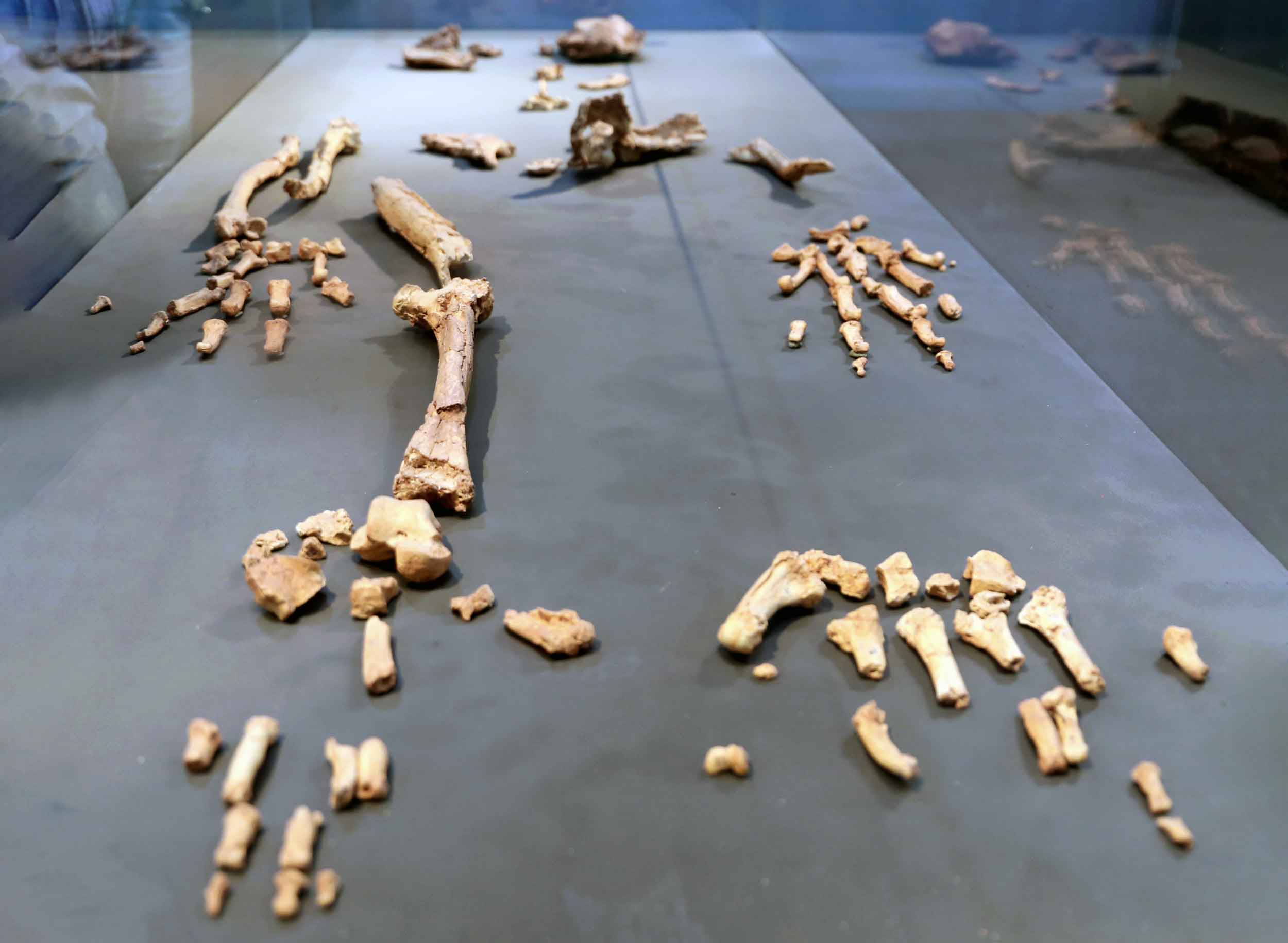
Ardipithecus ramidus has the most substantial fossil record of these species of early hominin relatives. The team led by Tim White first identified fossils of this species at Aramis, and in 1994 Yohannes Haile-Selassie discovered the first pieces of a partial skeleton, ARA-VP-6/500. Ultimately the team would collect much of the hands and feet, substantial portions of the upper and lower limbs and pelvis, and the partial skull and teeth of this individual, commonly called “Ardi”. A second more fragmentary skeleton from the Gona study area, designated as GWM67/P2, provides additional information about the anatomy of Ar. ramidus.
The Ardi skeleton had a foot with an opposable big toe, which is similar to great apes. It had a long hand and finger bones, and a short thumb, with long and strongly curved radius and ulna, and the arms and legs were close to the same length. All these features attest that this species was built for climbing. At the same time, some aspects of the skeleton show a reliance on upright posture or bipedal movement, whether in trees or on the ground. As in S. tchadensis, the Ar. ramidus skull had a forward-placed foramen magnum. The partial pelvis has a shorter ilium than in any living great apes, curved slightly around the trunk, and a noticeable anterior inferior iliac spine. While its configuration was still quite different from Australopithecus or Homo, the Ar. ramidus pelvis would have better enabled bipedal walking than any living great apes. This skeleton was similar in size to the S. tchadensis and O. tugenensis material, around 30–45 kg.
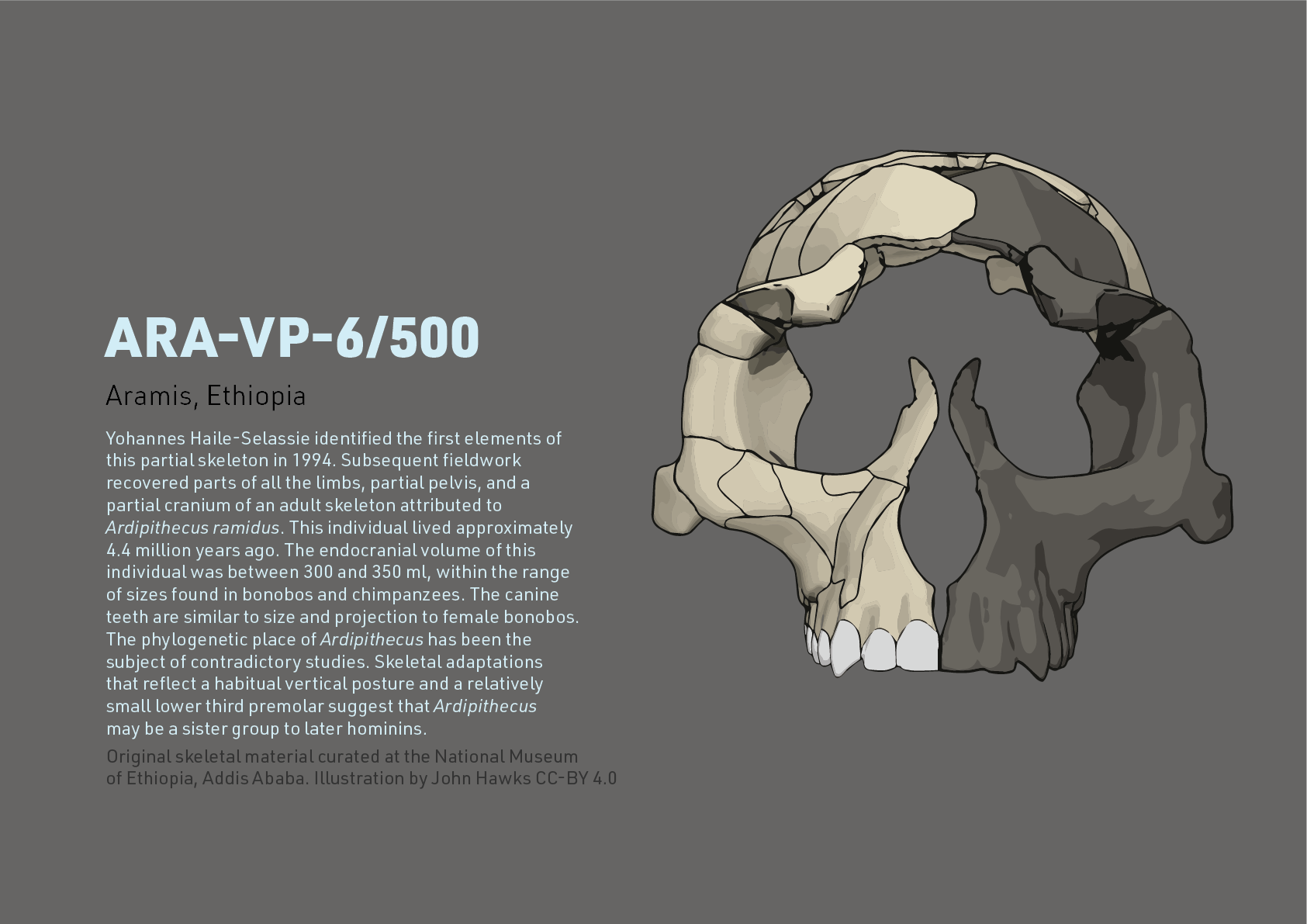
The entire sample of Ar. ramidus molars and premolars are small in size compared to Au. afarensis and Au. anamensis teeth, found in the same part of Ethiopia a few hundred thousand years later in time. As in S. tchadensis and O. tugenensis, the upper and lower canine teeth are similar in size to the canines of female bonobos, and the upper canine does not have effective honing wear against the lower P3. The known sample of Ar. ramidus does not include any markedly larger canines, suggesting that canine size dimorphism in this species was very low, again different from living great apes. A large fraction of the Ar. ramidus fossil sample comes from a narrow time window around 4.4 million years, providing a picture of the species biology in a delimited time and place. What is uncertain is how extensive the range of the species may have been, and when it ultimately became extinct.
Ardipithecus kadabba
- First appearance: 6.3 million years, Asbole Dora, Ethiopia
- Last appearance: 5.6–5.2 million years, Amba, Ethiopia
- Holotype: ALA-VP-2/10 fossil mandible, Alayla, Ethiopia
- Named by: Yohannes Haile-Selassie in 2001 described a number of fossils, all older than known fossils of Ardipithecus ramidus, as a subspecies of that species, Ar. r. kadabba. Later, in 2004, Haile-Selassie and collaborators elevated this to the species level.
- Etymology: In the Afar language, ardi means “ground” or “floor”, while pithekos is the Greek word for monkey or ape. The word kadabba in Afar has the meaning of “basal family ancestor”.
Ar. kadabba is known from several localities from the western margin of the Middle Awash field area of Ethiopia. These localities include Alayla, where the holotype specimen was found in 1997, Saitune Dora, Asa Koma, Digiba Dora, and Amba East. In addition to these sites in the Middle Awash area, Scott Simpson and colleagues in a 2015 study reported five Late Miocene teeth from the Adu-Asa Formation of the Gona research area that they attributed to Ar. kadabba.
Compared to the better-known Ar. ramidus, the fossil record of Ar. kadabba is sparse. A few details of the teeth set the earlier species apart, centered around the canine and lower premolar morphology for which Ar. kadabba retains a bit more of the C/P3 honing potential than Ar. ramidus. The few postcranial fossils that are from these sites, including some upper limb fragments and a toe phalanx, are similar in morphology and size to their Ar. ramidus counterparts.
Relationships to other hominins
Experts who have studied these fossil species disagree about their relationships to other hominins and to each other. Several challenges stand in the way of a clear interpretation of their phylogeny. Probably the deepest challenge is that we are not sure exactly what the common ancestors of hominins, bonobos, and chimpanzees looked like. This makes it hard to evaluate whether hominin-like features are unique evidence of a relationship, or whether they were inherited from an older Miocene stem.
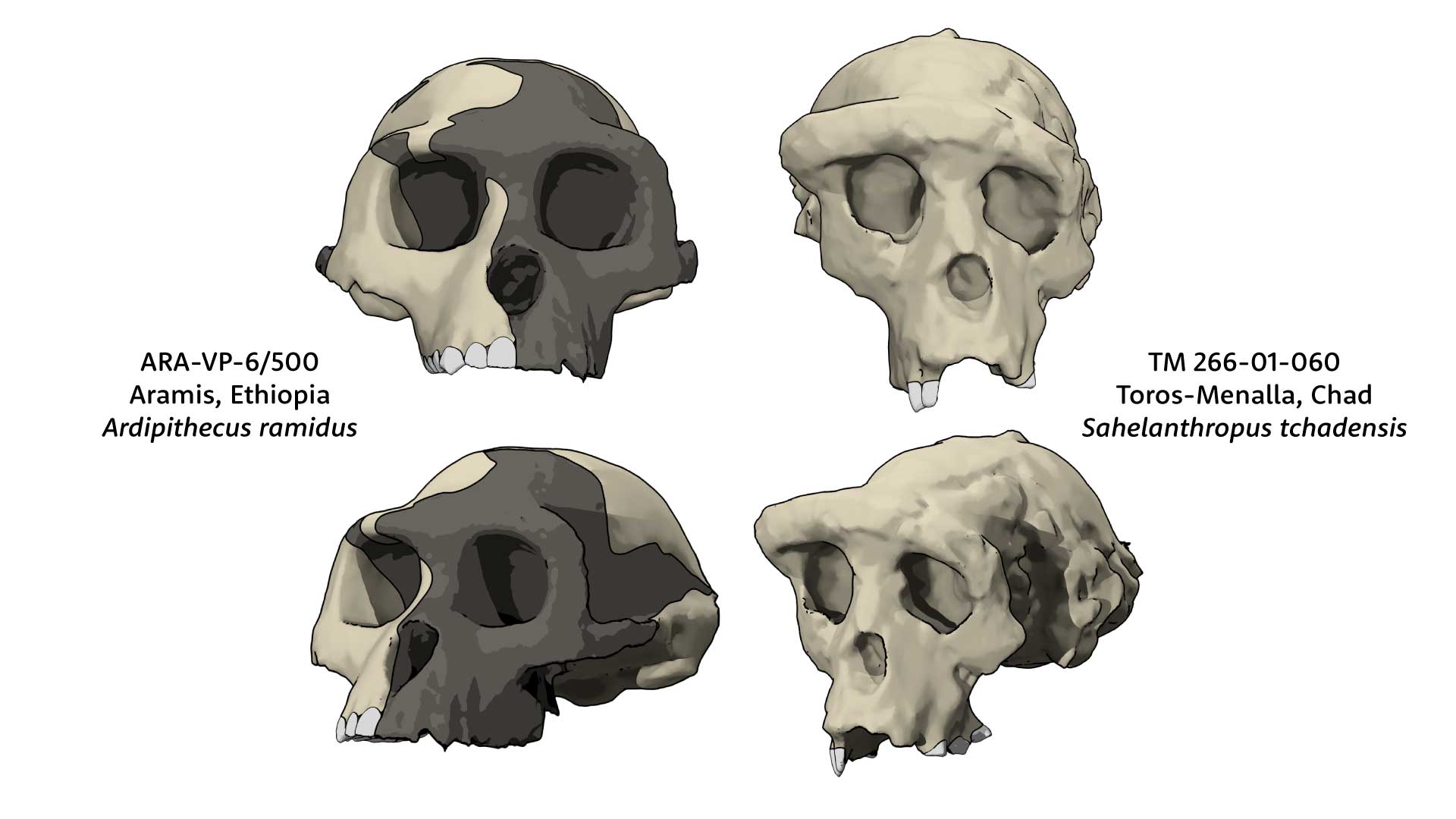
Several dental and cranial features point to a sister relationship between Sahelanthropus, Orrorin, and Ardipithecus and later hominins. All these species share a functional loss of C/P3 honing with smaller canines and canine roots than in living great apes. The incisors of these species are small compared to living great apes, as in Australopithecus and Homo. In both S. tchadensis and Ar. ramidus the base of the skull is hominin-like, with the foramen magnum oriented to support the skull better in a vertical posture.
On the other hand, all three genera differ from later hominins in fundamental ways. Some of those ways involve the dentition. Neither Ardipithecus, Sahelanthropus nor Orrorin have the large molars and premolars, very thick enamel, nor the changes in canine morphology that are shared by all later hominins. Other differences involve the postcranial skeleton. Later hominins all share a large set of derived features of the pelvis, lower limb, foot, upper limb, and hand that are absent in Ar. ramidus. Fossils of S. tchadensis include a femur that differs from later hominins in some important ways; Orrorin tugenensis has femoral morphology that is most similar to later hominins. On the other hand, Sergio Almécija and coworkers in a 2013 paper noted several aspects of the O. tugenensis femoral morphology are also shared with apes that lived earlier in the Miocene. The differences in femur form between Orrorin and today's chimpanzees, bonobos, and gorillas certainly show that Orrorin did not move quadrupedally in the way these primates do, but may not reflect the same extent of commitment to bipedal movement as other fossil hominins.
Most anthropologists interpret this pattern as a few shared features with Australopithecus and many features unchanged from ancestral apes. A tree of relationships that fits this idea is one in which Australopithecus, Homo, and other fully bipedal hominins belong to a single branch, while Ardipithecus, Orrorin, and Sahelanthropus are each sister groups to that branch. Some researchers favor the idea that all three may lie on a single branch with a Sahelanthropus-like common ancestor. But some scientists remain skeptical of a close link between each of these early genera and Australopithecus or other hominins. For example, Milford Wolpoff and coworkers in a 2006 paper noted that many of the dental and cranial traits that appear to link S. tchadensis with later hominins actually can be found in some earlier Miocene apes.
Could these species all be the same?
Orrorin tugenensis, Ar. kadabba, and S. tchadensis were first described in 2001 and 2002, a time when only a handful of fossils of Ar. ramidus were available for study. Each had been defined from fossils that preserved different aspects of the anatomy, and the only parts of the anatomy that could be compared in all four species were the teeth and mandibles. With such limited evidence, many researchers wondered whether these early hominins might really all represent a single species.

This question was raised most pointedly by Yohannes Haile-Selassie, Tim White, and Gen Suwa in a 2004 study. They reviewed the dental morphology of the Ardipithecus fossils published at that time, providing a justification for Ar. kadabba as a species instead of a subspecies of Ar. ramidus. But they also noted the similarity in size and shape of Ardipithecus to the known O. tugenensis and S. tchadensis samples, concluding that all these might actually be the same kind of primate.
“Given the limited data currently available, it is possible that all of these remains represent specific or subspecific variation within a single genus.”—Yohannes Haile-Selassie, Tim White, and Gen Suwa
At that time, the S. tchadensis postcranial sample was awaiting description, along with most of the Ar. ramidus postcranial remains. Now, almost twenty years later, much more evidence has been presented for these species. The more complete skeletal remains of Ar. ramidus, S. tchadensis, and O. tugenensis contrast with each other in ways that suggest some real differences in locomotor strategy. In some ways the picture of similar teeth and diverse postcranial adaptations for these earliest hominin species may be a counterpoint to the similar postcrania and diverse teeth that we see in later hominins.
A link to Homo?
Martin Pickford and coworkers in 2022 suggested a different scenario for the relationships of these fossil species. They observe that both O. tugenensis and O. praegens have molar and premolar sizes, enamel thickness, and relative sizes of the molar and incisor rows that are quite different from Au. afarensis and Au. africanus but more similar to early species of Homo. If Homo had evolved from an Orrorin-like ancestor instead of Australopithecus, it would eliminate the necessity to imagine that molar size, enamel thickness, and mandibular robusticity all evolved toward larger size and then reversed themselves in Homo.
To some extent, the same question might be asked for S. tchadensis and Ar. ramidus. These species also have smaller molars and premolars than Au. afarensis. But evidence from the postcranial skeleton sets these other hominins apart. Australopithecus, Homo, and Paranthropus all share adaptations to bipedal locomotion that the Ar. ramidus skeleton lacks. The fossils of S. tchadensis provide less information but the femur clearly differs from later hominins.

By contrast the femora of O. tugenensis are more like those of Australopithecus. The genus Homo itself was once thought to have first appeared after 2.5 million years ago, but its first appearance is now 2.8 million. If the common ancestor of Homo and Australopithecus was actually a late form of Orrorin, then large-toothed Australopithecus would not have to revert to smaller toothed Homo. A tree consistent with the idea is illustrated here, with K. platyops forming a possible smaller-toothed sister group with Homo.
Is such a scenario likely? Personally, the similarities of Au. sediba and Homo persuade me that Homo came from an Australopithecus-like ancestor. It's true that the evolution of early Homo must reverse some aspects of cranial and dental form and robusticity, but Au. sediba demonstrates such reversal must have happened. But very little evidence excludes Orrorin from this part of the hominin tree. Considering that nearly all phylogenetic hypothesis testing has relied on the skulls and teeth, better representation of postcranial skeletons might change our ideas substantially. As it is, the femoral morphology of O. tugenensis is some of the strongest evidence that this species, at least, belongs to the hominins.
Outside the narrow windows
One lingering question is whether one or more of the species of Sahelanthropus, Orrorin, or Ardipithecus may have existed outside the three regions where they have been identified. Across the continent of Africa, these areas are the main source of information about the latest Miocene and earliest Pliocene. Almost certainly the habitat the sustained these apes was much more extensive, and we know that species of apes much earlier in the Miocene were successful in dispersing into varied parts of Africa and beyond. Extinct relatives of the African apes existed in Europe and Anatolia during the period between 12 million and 7 million years ago. Although none of these have yet been linked closely with hominins, some paleontologists think that these extinct Eurasian apes may share postural and locomotor similarities with the earliest hominins.
Two fossil sites hint that one or more of the early genera may have persisted after 4.1 million years ago. A partial foot from Burtele, Ethiopia, which is around 3.4 million years old, shows some evidence that the big toe was capable of being opposed against the other toes. Yohannes Haile-Selassie and coworkers have suggested that this Burtele foot may represent a lineage different from Australopithecus, and one possibility is that Ardipithecus or another earlier form may have persisted into the later Pliocene.
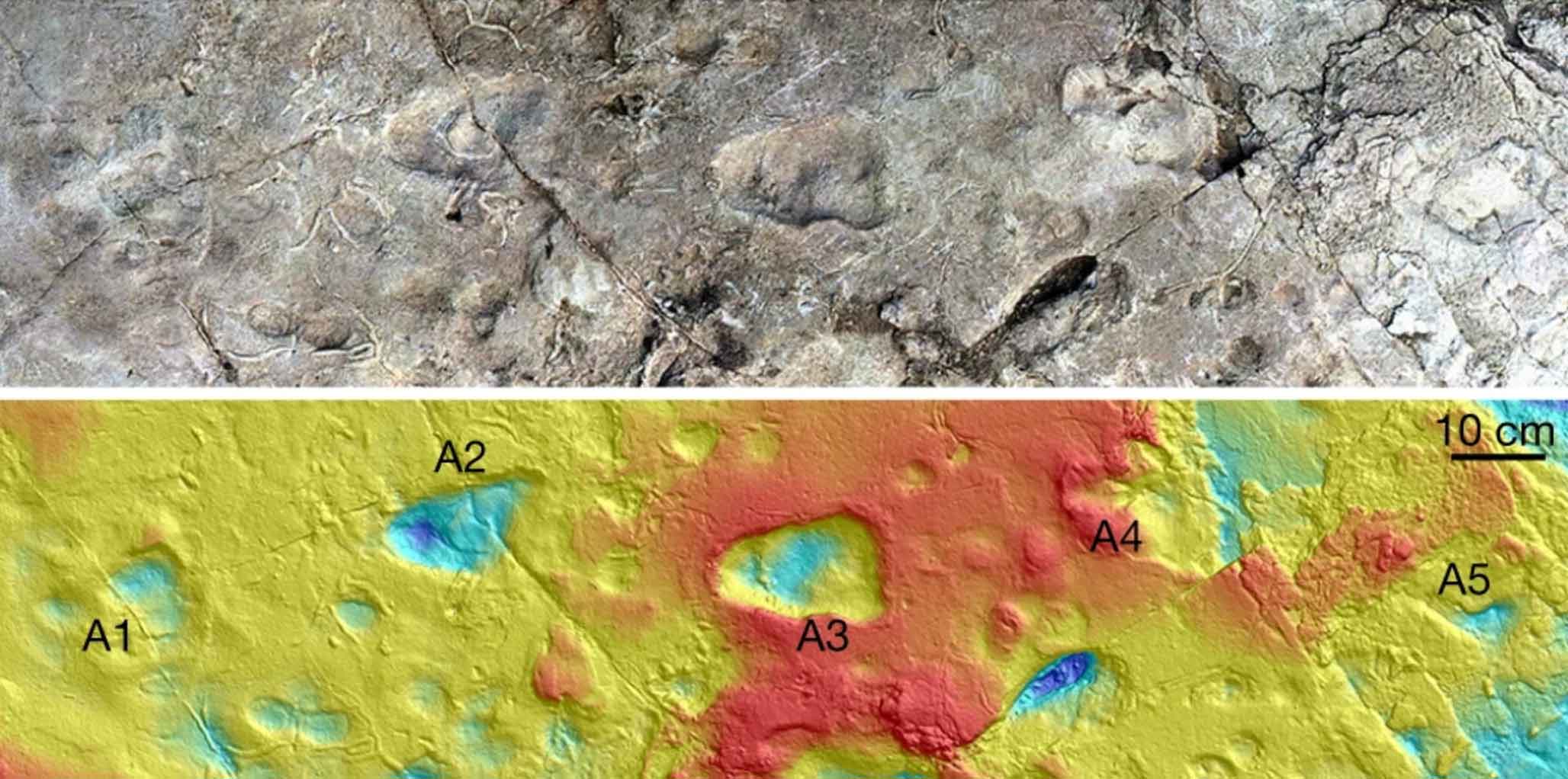
Another site is Laetoli, Tanzania, where many series of fossil footprints represent the movement of hominins and other animals from around 3.6 million years ago. Most of the bipedal trackways represent feet that are fundamentally humanlike: big toes aligned with the other toes and some degree of a longitudinal arch. But one of the trackways, designated as site “A”, represents an individual with very short and wide feet. Analysis of these prints by Ellison McNutt and collaborators in 2021 suggested that some other form of hominin was at the site.
“We therefore conclude that the site A footprints were made by a bipedal hominin with a distinct and presumably more primitive foot than A. afarensis. The gross shape of the foot is chimpanzee-like, with slight hallucial divergence and perhaps some midfoot mobility.”—Ellison McNutt and coworkers
The earliest human relatives like Ardipithecus, Orrorin, and Sahelanthropus were successful primates. The evidence suggests that Ardipithecus existed for at least 1.5 million years, and Orrorin may have existed even longer. These two lineages present several contrasts in their locomotor and dental adaptations, a sign that diversity was an important part of the landscape of early hominins. It would not surprise me if one or both of these lineages continued to survive well after 4.4 million years ago. If so, they would have encountered early Australopithecus. The big topics of later human evolution, hybridization and interaction, may well have mattered to these earliest hominins too.
Notes: Some of my own scientific research has involved these earliest hominins. I've been fortunate to be part of some fun scientific work to understand how these fossil species may be related to humans or other primates. I'm so happy to see new research growing from researchers who are adding more information from Miocene apes to interpret the lives of these hominin relatives.
As I was talking about these species with my students the other day, I realized how many stories there are about the discovery of these early fossils and their subsequent histories. I've written about many of those here over the past nineteen years. Especially Sahelanthropus has involved a dramatic series of personal stories and intrigue from various scientists involved in the discovery and analysis. Ardipithecus, too, especially Ar. ramidus, has given rise to both exciting advances and some conspiracy theories. I am sure many more stories are waiting to be told, and I know a few that it's not my place to tell.
Much more could be added about the locomotor anatomy and other aspects of the skeleton of Sahelanthropus and Ardipithecus. That will be covered in additional posts. The references below include key sources for the species themselves, their geological age, and some articles that have been important sources of interpretation for them. A complete list of interpretations would be far beyond the scope of this post.
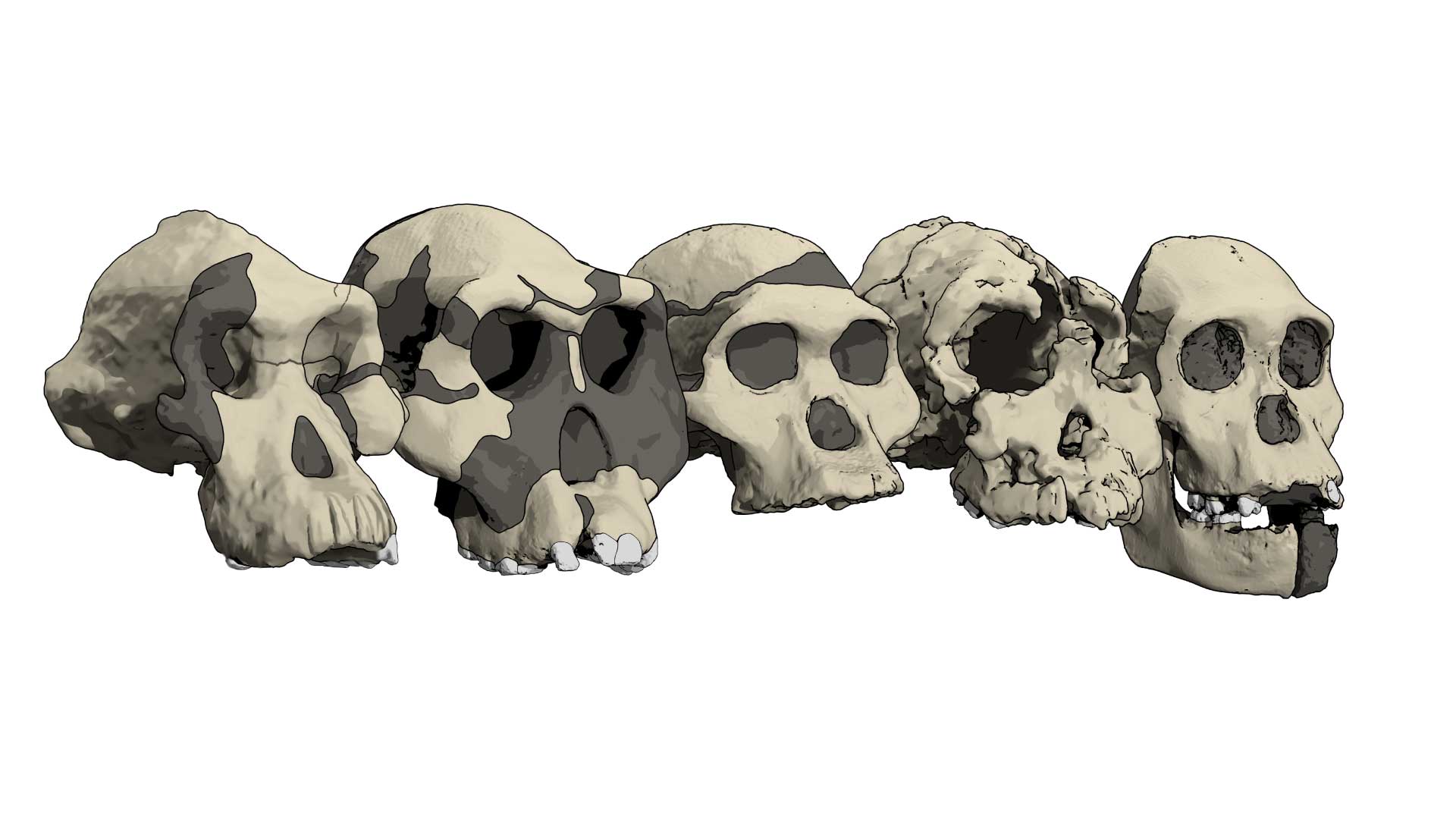
References
Brunet, M., Guy, F., Pilbeam, D., Lieberman, D. E., Likius, A., Mackaye, H. T., Ponce de León, M. S., Zollikofer, C. P. E., & Vignaud, P. (2005). New material of the earliest hominid from the Upper Miocene of Chad. Nature, 434(7034), Article 7034. https://doi.org/10.1038/nature03392
Brunet, M., Guy, F., Pilbeam, D., Mackaye, H. T., Likius, A., Ahounta, D., Beauvilain, A., Blondel, C., Bocherens, H., Boisserie, J.-R., De Bonis, L., Coppens, Y., Dejax, J., Denys, C., Duringer, P., Eisenmann, V., Fanone, G., Fronty, P., Geraads, D., … Zollikofer, C. (2002). A new hominid from the Upper Miocene of Chad, Central Africa. Nature, 418(6894), Article 6894. https://doi.org/10.1038/nature00879
Daver, G., Guy, F., Mackaye, H. T., Likius, A., Boisserie, J.-R., Moussa, A., Pallas, L., Vignaud, P., & Clarisse, N. D. (2022). Postcranial evidence of late Miocene hominin bipedalism in Chad. Nature, 609(7925), Article 7925. https://doi.org/10.1038/s41586-022-04901-z
Deino, A. L., Tauxe, L., Monaghan, M., & Hill, A. (2002). 40Ar/39Ar geochronology and paleomagnetic stratigraphy of the Lukeino and lower Chemeron Formations at Tabarin and Kapcheberek, Tugen Hills, Kenya. Journal of Human Evolution, 42(1), 117–140. https://doi.org/10.1006/jhev.2001.0521
Ferguson, W. W. (1989). Taxonomic status of the hominid mandible KNM-ER TI 13150 from the middle pliocene of tabarin, in Kenya. Primates, 30(3), 383–387. https://doi.org/10.1007/BF02381261
Haile-Selassie, Y. (2001). Late Miocene hominids from the Middle Awash, Ethiopia. Nature, 412(6843), Article 6843. https://doi.org/10.1038/35084063
Haile-Selassie, Y., Saylor, B. Z., Deino, A., Levin, N. E., Alene, M., & Latimer, B. M. (2012). A new hominin foot from Ethiopia shows multiple Pliocene bipedal adaptations. Nature, 483(7391), Article 7391. https://doi.org/10.1038/nature10922
Haile-Selassie, Y., Suwa, G., & White, T. D. (2004). Late Miocene Teeth from Middle Awash, Ethiopia, and Early Hominid Dental Evolution. Science, 303(5663), 1503–1505. https://doi.org/10.1126/science.1092978
Haile-Selassie, Y., & WoldeGabriel, G. (2009). Ardipithecus Kadabba: Late Miocene Evidence from the Middle Awash, Ethiopia. University of California Press.Hawks, J. (2018). Ardipithecus. In The International Encyclopedia of Biological Anthropology (pp. 1–8). John Wiley & Sons, Ltd. https://doi.org/10.1002/9781118584538.ieba0035
Hill, A. (1985). Early hominid from Baringo, Kenya. Nature, 315(6016), Article 6016. https://doi.org/10.1038/315222a0
Hill, A., & Ward, S. (1988). Origin of the Hominidae: The record of african large hominoid evolution between 14 my and 4 my. American Journal of Physical Anthropology, 31(S9), 49–83. https://doi.org/10.1002/ajpa.1330310505
Kissel, Marc & Hawks, John. (2015). What are the Lothagam and Tabarin Mandibles? PaleoAnthropology, 2015, 37–43. https://paleoanthropology.org/ojs/index.php/paleo/article/view/730
Lebatard, A.-E., Bourlès, D. L., Duringer, P., Jolivet, M., Braucher, R., Carcaillet, J., Schuster, M., Arnaud, N., Monié, P., Lihoreau, F., Likius, A., Mackaye, H. T., Vignaud, P., & Brunet, M. (2008). Cosmogenic nuclide dating of Sahelanthropus tchadensis and Australopithecus bahrelghazali: Mio-Pliocene hominids from Chad. Proceedings of the National Academy of Sciences, 105(9), 3226–3231. https://doi.org/10.1073/pnas.0708015105
Macchiarelli, R., Bergeret-Medina, A., Marchi, D., & Wood, B. (2020). Nature and relationships of Sahelanthropus tchadensis. Journal of Human Evolution, 149, 102898. https://doi.org/10.1016/j.jhevol.2020.102898
McNutt, E. J., Hatala, K. G., Miller, C., Adams, J., Casana, J., Deane, A. S., Dominy, N. J., Fabian, K., Fannin, L. D., Gaughan, S., Gill, S. V., Gurtu, J., Gustafson, E., Hill, A. C., Johnson, C., Kallindo, S., Kilham, B., Kilham, P., Kim, E., … DeSilva, J. M. (2021). Footprint evidence of early hominin locomotor diversity at Laetoli, Tanzania. Nature, 600(7889), Article 7889. https://doi.org/10.1038/s41586-021-04187-7
Prang, T. C. (2019). The African ape-like foot of Ardipithecus ramidus and its implications for the origin of bipedalism. eLife, 8, e44433. https://doi.org/10.7554/eLife.44433
Prang, T. C., Ramirez, K., Grabowski, M., & Williams, S. A. (2021). Ardipithecus hand provides evidence that humans and chimpanzees evolved from an ancestor with suspensory adaptations. Science Advances, 7(9), eabf2474. https://doi.org/10.1126/sciadv.abf2474
Sawada, Y., Pickford, M., Senut, B., Itaya, T., Hyodo, M., Miura, T., Kashine, C., Chujo, T., & Fujii, H. (2002). The age of Orrorin tugenensis, an early hominid from the Tugen Hills, Kenya. Comptes Rendus Palevol, 1(5), 293–303. https://doi.org/10.1016/S1631-0683(02)00036-2
Senut, B., Pickford, M., Gommery, D., Mein, P., Cheboi, K., & Coppens, Y. (2001). First hominid from the Miocene (Lukeino Formation, Kenya). Comptes Rendus de l’Académie Des Sciences - Series IIA - Earth and Planetary Science, 332(2), 137–144. https://doi.org/10.1016/S1251-8050(01)01529-4
Simpson, S. W., Kleinsasser, L., Quade, J., Levin, N. E., McIntosh, W. C., Dunbar, N., Semaw, S., & Rogers, M. J. (2015). Late Miocene hominin teeth from the Gona Paleoanthropological Research Project area, Afar, Ethiopia. Journal of Human Evolution, 81, 68–82. https://doi.org/10.1016/j.jhevol.2014.07.004
Simpson, S. W., Levin, N. E., Quade, J., Rogers, M. J., & Semaw, S. (2019). Ardipithecus ramidus postcrania from the Gona Project area, Afar Regional State, Ethiopia. Journal of Human Evolution, 129, 1–45. https://doi.org/10.1016/j.jhevol.2018.12.005
Suwa, G., Kono, R. T., Simpson, S. W., Asfaw, B., Lovejoy, C. O., & White, T. D. (2009). Paleobiological Implications of the Ardipithecus ramidus Dentition. Science, 326(5949), 69–99. https://doi.org/10.1126/science.1175824
Suwa, G., Sasaki, T., Semaw, S., Rogers, M. J., Simpson, S. W., Kunimatsu, Y., Nakatsukasa, M., Kono, R. T., Zhang, Y., Beyene, Y., Asfaw, B., & White, T. D. (2021). Canine sexual dimorphism in Ardipithecus ramidus was nearly human-like. Proceedings of the National Academy of Sciences, 118(49), e2116630118. https://doi.org/10.1073/pnas.2116630118
White, T. D., Suwa, G., & Asfaw, B. (1994). Australopithecus ramidus, a new species of early hominid from Aramis, Ethiopia. Nature, 371(6495), Article 6495. https://doi.org/10.1038/371306a0
WoldeGabriel, G., Ambrose, S. H., Barboni, D., Bonnefille, R., Bremond, L., Currie, B., DeGusta, D., Hart, W. K., Murray, A. M., Renne, P. R., Jolly-Saad, M. C., Stewart, K. M., & White, T. D. (2009). The Geological, Isotopic, Botanical, Invertebrate, and Lower Vertebrate Surroundings of Ardipithecus ramidus. Science, 326(5949), 65-65e5. https://doi.org/10.1126/science.1175817
WoldeGabriel, G., Haile-Selassie, Y., Renne, P. R., Hart, W. K., Ambrose, S. H., Asfaw, B., Heiken, G., & White, T. (2001). Geology and palaeontology of the Late Miocene Middle Awash valley, Afar rift, Ethiopia. Nature, 412(6843), Article 6843. https://doi.org/10.1038/35084058
Wolpoff, Milford H., Hawks, John, Senut, Brigitte, Pickford, Martin, & Ahern, James. (2006). An Ape or the Ape: Is the Toumaï Cranium TM 266 a Hominid? PaleoAnthropology, 2006, 36–50. https://www.paleoanthropology.org/ojs/index.php/paleo/article/download/513/474
John Hawks Newsletter
Join the newsletter to receive the latest updates in your inbox.


